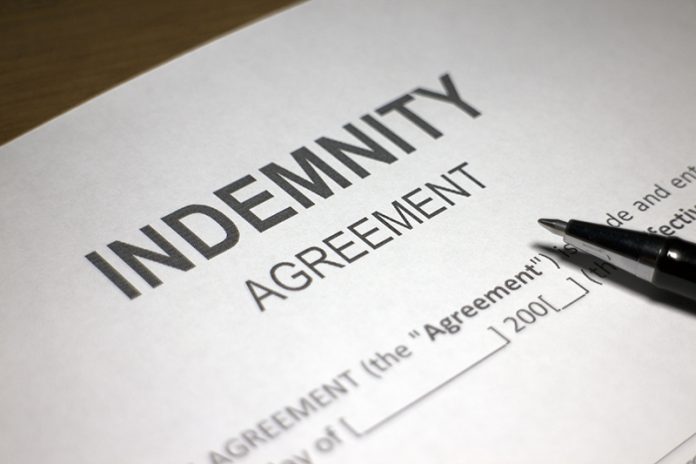This article is written by Bhavya Shah pursuing a Diploma in Advanced Contract Drafting, Negotiation, and Dispute resolution from Lawsikho. This article has been edited by Ojuswi (Associate, Lawsikho).
This article has been published by Sneha Mahawar.
Table of Contents
Introduction
The terms ‘Indemnity’ and ‘Hold Harmless’ are perfectly synonymous words regarding contracts and agreements, yet bearing completely different meanings but still used widely. The same. remedies may be claimed by the aggrieved party for breach of contract. An Indemnification and hold harmless agreement are an agreement that is duty bound where the liability of one or multiple parties to a contract is defined on the loss or damages of either party. This article will focus on explaining what indemnity clauses and hold harmless clauses are, how they are different, and their impact on the contracts.
What is indemnity
Indemnity is an assurance to make good monetary or other loss that may be caused due to loss or damages. According to Lexis Nexis indemnity is “An Agreement by the party who bears the cost of certain losses or liabilities incurred by another party in certain circumstances, is termed as Indemnity”.
Chapter VIII of the Indian Contract Act, 1872 Contains legal provisions dealing with the contract of indemnity. Section 124 of the Indian Contract Act,1872 states that “A Contract wherein one party promises to save the other from loss caused to him by the conduct of the promisor himself, or by the conduct of any other person” Further Section 125 of the Indian Contract Act, 1872 Provides remedy to the promise in a Contract of Indemnity acting within the scope of its authority.
Illustration
P agrees to take assurance against Q, and Q takes a loan of Rs. 500 from R, If Q is unable to pay the loan, P will be required to pay R on behalf of Q. Here P compensates R for his losses inquired by Q on non-payment of the loan amount. The Example above explains that P agrees to Indemnify R against loss or liabilities or potential liabilities of R for arising any claims for damages.
Meaning of the indemnity clause
The word ‘Indemnity’ derives from the Latin Word indemnis the meaning of harmless forms with facere meaning to make. In Contract Law, an Indemnity clause is a deeply discussed and negotiated clause. It is one of the imperative clauses, which assures the indemnity of the liabilities or loss suffered by the Indemnity Holder.
The term ‘Indemnity’ can be defined as a security or protection against a financial burden, or liabilities against any loss or risk. In the Indemnity clause, a party who bears the financial burden is indemnifying party called an indemnifier, who promises to secure another party to the contract from any loss, liabilities, damage, or any other legal risk caused due to an act or omission by the conduct of indemnifier himself or any third party or an event.
In total, the Fundamental canon of the Indemnity clause in an agreement or contract is to transfer or shift liability partially or wholly from one party to another.
Types of indemnity
Broad indemnification
The Promisor promises to indemnify the Promisee against the negligence of all parties, including third parties, even if the Promisor had nothing to do with the negligence. For this reason, Broad Indemnification is rarely used and is considered to be illegal and determined coercive in nature
Intermediate indemnification
The Promisor promises to indemnify the Promisee against the negligence of the Promisee and the Promisor. Indemnity does not extend to the actions of third parties.
Limited indemnification
The Promisor promises to indemnify the Promisee only against the negligence of the Promisor for which the Promisee is held liable. The indemnity does not extend to the actions of the Promisee and third parties.
Drawbacks of indemnity clauses
An Indemnity Clause of a contract needs to be handled with the utmost care, there are multiple ways in which it can be mismanaged or misdirected, to the prospective disadvantage of the person dealing with this contract. Some of the following ways are:
- At times, Indemnity Clauses are usually outlined too loosely. and seek protection against unlikely occurrences of scenarios. The broader disadvantage of loose-ended contracts is that in the desire to cover the largest possible course of events, the clause will be too ambiguous to address the happening of an event. In the case of indemnity, particularity and relevance are to be kept in mind
- The powers of indemnity will be run by the statute of Limitation and Breach of Contract claim, which is generally capped from when the breach of contract occurred in fact, the Indemnity Limitation begins from the time a party makes an indemnity Claim.
- Many Contract lawyers or contract drafters consider the Indemnity clause as a Boilerplate Clause that does not need detailed attention, but that is where the majority of the contract lawyers could have been mistaken. Any loose-end assumptions of any clause in a contract could land one in legal situations that were not apprehended. In the case of indemnity, the assumption of protection, which is usually lacking in reality, can land one in a hitch.
Key points for drafting of indemnity clause
While drafting an indemnity clause in a contract following key points needs to adhere to:
Identity of the parties
Who is the Indemnifier and who is the indemnitee? And one needs to mention the personal information carefully and also provide KYC details.
Duration of claim
While entering into an Indemnity provider must limit the number of indemnities given into a Contract. An Obligation must be imposed to reduce the burden of loss and the claim which can be brought shall be in a limited duration of time.
Requirement for the clause
Is there any call for an indemnity clause in an agreement or contract? An indemnity clause is not required if it does not provide additional protection for the breach of contract than it normally would be available for the breach of contract under the common law.
Drafted in a wide manner
The indemnity Clause must never be drafted extensively as it not only risks the effect of achieving the desired claims but also excludes some anticipated liabilities.
What is hold harmless
A provision Hold Harmless or liability of waiver in a contract or an agreement between two parties or more whereby either party agrees not to hold the other party responsible for any loss, risk damage, or consequences that may take place under the agreement. Namely, two parties cannot sue each other for any loss or liabilities they may suffer even if it’s due to the other party’s negligence. Hold harmless provisions are often combined and are interchangeably used with indemnity provisions.
Illustration
Mr. A will be responsible for meeting A’s tax liabilities and will hold harmless B against any claims tax authorities indicates that if A is subject to a claim for the tax to be paid on the transaction between A and B, A will not try to blame B, or join B in legal proceedings, and will also repay any expenses or costs B incurs if anyone else claims against B to recover what is agreed.
Meaning of hold harmless
A Hold Harmless is a common clause in legal contracts and is a core concept in risk transfer. A Hold harmless rescues one party from consequences or liabilities due to the acts of another party. Particularly, the party granting the hold harmless to a third-party shift some or all of the risks onto itself away from that third party. According to Cornell Law School, Hold Harmless is stated as a Promisor in a contract does not hold the Promisee or third party responsible for any loss or liabilities if the Promisee or third party carries out the contract in a way that causes damage to the Promisor.
At times, A Hold harmless agreement may also be referred to as an indemnification clause. However, this is a mystery because indemnification and holding harmless are two different things. While both require a party to assume responsibilities for another party, a hold harmless may require a party to assume responsibility for making another party whole, as well as assuming liability, whereas an indemnification agreement may only require making the other party whole due to certain financial losses.
Types of hold harmless clauses
When one Party will agree not to hold the other party responsible is a unilateral approach and when both the Parties agree not to hold each other accountable and bear the cost of liabilities or damages individually is termed a reciprocal Approach of holding another person harmless.
Broad form
When one party takes on all responsibilities for any liabilities, risk, damages, expenses, mistakes, or its own negligence, or conduct of a third party or that of the Promisee. This type of Hold harmless Clause is to be complied with caution and take acute measures to assess the risk.
Limited form
When one Party will be responsible for any accident, Liability, or error which can be accessed in a limited manner. The party will be held responsible for only that part of the damages that are caused due to his own negligence. Usually, in such cases, both the parties have their own hold harmless clauses or separate hold harmless agreements to secure their risk obligation.
Intermediate form
When one party takes on responsibility for all liability, Errors, or Damages, caused by him, He shall not only be liable for his own negligence but also for the third party and Promisee’s negligence or conduct. If both the parties acted wrongly then each party will only be liable for his own conduct. This is a most inclined approach for holding harmless clauses, wherein the question is not relying on whose fault it was but rather dependent on who will actually bear the losses.
Protection under hold harmless agreement
A Hold Harmless clause is a translucent clause indicating that an individual or entity shall not be held liable for any actions that are caused due to negligence or by the conduct of any third party to another individual or enterprise. Actions are any Risk, Danger, Injury, or Damage which is caused due by one party to another. The hold harmless clause provides the highest protection. Hold Harmless is neither limited to a breach of contract and claiming damages, nor is it a pre-defined blanket of protection like an indemnification. Generally, when such a clause is signed, there is some degree of unavoidable risk that involves an activity or investment, herein one party holds another party harmless, it purely means one may not blame another party for any loss or liability. Despite the similarities with the other risk mechanism, hold harmless provides the greatest protection but it depends on how the contract is articulated.
Dangers of a hold harmless clause
A hold harmless clause aims to impose on one party the responsibility to pay all liability, damages, costs, expenses, and even legal proceeding fees for the other party to the Contract. The Promisor is responsible to pay the damages to the Promisee even if the Promisee’s negligence obligates the Promisor to pay off the Liability.
Illustration
Mr. A is hired to clean a car in the parking lot and enters into a contract with Mr. B who is the owner of the car. A few months later Mr. A while cleaning the car in the parking lot damaged the Car of Mr. W, herein the car owner wants payment for damages and additional expenses. When Mr. W sends the claim to Mr. A with the understanding that he will pay the damage caused, he refers to the signed contract which includes a hold harmless clause that compels Mr. B to pay for any damages done by Mr. A
Key points for the drafting of hold harmless clause
While drafting a Hold Harmless clause in a contract following key points needs to adhere to:
Before jumping to draft a Hold Harmless Clause, one needs to prepare a list of all information (Effective date, Governing laws, Risk Assessment) and have a comprehensive discussion with the parties
Identity of the parties
The name and address of the party who will not be held liable for any consequences. The name and address of the party who will be offering protection from liability.
Effective date
The date upon which the agreement was executed. If such information is not communicated consider the date of execution as the effective date.
Governing laws
The state whose laws will be governed under this contract shall be properly drafted. The governing laws will define the jurisdiction of the parties.
Under English Law and Indian Law
In English Law, the two terms have been held to be interchangeable. Black Law Dictionary Revised Fourth Edition Define Hold Harmless as ‘ To discharge another party from any obligation for any damages or other liability arising from the transaction. The definition is very similar to the term Indemnity and indicates that the two terms are synonyms. Bryan A. Garner, Indemnify A. and Hold Harmless; Save Harmless[15 Green Bag 2d 17,23 (2011)] stated that “Indemnity and Hold Harmless means nothing more than indemnity alone and that indemnity and hold harmless are synonymous and mean the same thing. In contrast, American law seems to not completely agree with this approach. Mellinkoff’s Dictionary of American legal usage states that ‘Indemnify’ is often used as a synonym for ‘Hold Harmless’. However, when differentiated from Hold Harmless, indemnification is defined as reimbursement for actual loss whereas Hold Harmless would include risk of loss and even Actual loss. Indemnification is narrower than hold harmless in terms of its definition. In the United States v. Contract Mgmt Inc.[912 F.2d 1045, 1048 (9th Cir. 1990)] the court held that indemnification grants an offensive right allowing a party to seek to indemnify whereas, Hold Harmless grants a defensive right, which safeguards a party from claims. In Indian Law, The Bombay high court in Gajan Moreshwar v. Moreshwar Madan (1942) held that the equitable principle applicable in England shall be applicable in India. As a result, the indemnity-holder has induced an absolute liability and the indemnifier shall rescue him from his obligation and pay it off.
Difference between indemnity and hold harmless
One Remarkable distinction between Hold Harmless and an Indemnity- Promisor granting a hold harmless not only shift risks to itself by taking accountability for another’s losses associated with that risk but also assumes the risk directly and agrees not to shift it to the Promisee even if the Promisee’s negligence is ultimately responsible.
| BASIC OF DIFFERENTIATION | DUTY TO INDEMNITY | DUTY TO HOLD HARMLESS |
MEANING | Protects against the actual losses | Protects against actual losses and risk of the liabilities |
PARTIES | Indemnifier accepts responsibility for all losses arising from, certain acts, circumstances, hiatus, or happening of events | Promisor assumes all liability and releases the Promisee from any liability resulting from certain defined acts, circumstances, and events. |
| ACCOUNTABILITY | Indemnifier has an obligation to pay and reimburse the Indemnitee for all indemnified losses | The promisor assumes responsibility for all associated risks, losses, and damages and effectively guarantees not to sue or seek to impose liability on the Promisee. |
SHIFTING RISK | Shifting risk from Indemnitee to itself (indemnifier) | Promisor retains the risk as well as shifts it to itself |
BROUGHT ON | The mutual agreement, assent on a settlement or proof of an indemnified loss, or acceptance of obligation of such losses. | The instance governed by hold harmless for any acts and circumstances |
Conclusion
Nowadays, Indemnity and Hold Harmless are synonymously used in legal contracts. This is not always accurate. An Agreement to indemnity means that the indemnifier agrees to reimburse the indemnitee for any damages or liability incurred in a certain situation. The indemnitee may first be required to pay and provide their own rebuttal and settlement. This can have a profound impression on the indemnitee. In comparing this with the Hold Harmless agreement, the party that is held harmless (i.e., Promisee) does not have to respond to a claim of the obligation, which is in turn transferred to the party holding them harmless. (i.e., Promisor)
The Importance of ensuring that risk allocations are recognized by the global enterprises in the current fluctuating market conditions. Market leaders are concerned about indemnification and hold harmless obligations that will fare in the face of increasing bankruptcy and dissolutions. By Approaching different defensive risk mechanisms using the duty to indemnify and duty to hold harmless in contract appropriately, the parties can make sure they are accepting an appropriate level of risk for carrying out legal obligations. Blindly entering into contracts without considering whether they are fulfilling their own legal obligations and rights could expose a business to greater risk or result in loss of rights one didn’t apprehend that they possessed.
References
- Difference between Indemnification and Hold Harmless
- Contract of indemnity
- Complete guide of Hold Harmless
Students of Lawsikho courses regularly produce writing assignments and work on practical exercises as a part of their coursework and develop themselves in real-life practical skills.
LawSikho has created a telegram group for exchanging legal knowledge, referrals, and various opportunities. You can click on this link and join:
Follow us on Instagram and subscribe to our YouTube channel for more amazing legal content.
















